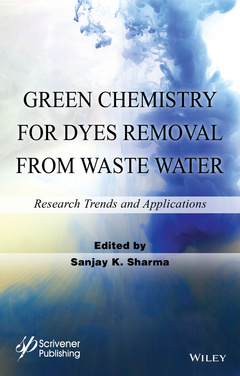Green Chemistry for Dyes Removal from Waste Water Research Trends and Applications
Coordonnateur : Sharma Sanjay K.

The use of synthetic chemical dyes in various industrial processes, including paper and pulp manufacturing, plastics, dyeing of cloth, leather treatment and printing, has increased considerably over the last few years, resulting in the release of dye-containing industrial effluents into the soil and aquatic ecosystems. The textile industry generates high-polluting wastewaters and their treatment is a very serious problem due to high total dissolved solids (TDS), presence of toxic heavy metals, and the non-biodegradable nature of the dyestuffs in the effluent.
The chapters in this book provide an overview of the problem and its solution from different angles. These problems and solutions are presented in a genuinely holistic way by world-renowned researchers. Discussed are various promising techniques to remove dyes, including the use of nanotechnology, ultrasound, microwave, catalysts, biosorption, enzymatic treatments, advanced oxidation processes, etc., all of which are "green."
Green Chemistry for Dyes Removal from Wastewater comprehensively discusses:
- Different types of dyes, their working and methodologies and various physical, chemical and biological treatment methods employed
- Application of advanced oxidation processes (AOPs) in dye removal whereby highly reactive hydroxyl radicals are generated chemically, photochemically and/or by radiolytic/ sonolytic means. The potential of ultrasound as an AOP is discussed as well.
- Nanotechnology in the treatment of dye removal types of adsorbents for removal of toxic pollutants from aquatic systems
- Photocatalytic oxidation process for dye degradation under both UV and visible light, application of solar light and solar photoreactor in dye degradation
Preface xiii
Acknowledgements xix
About the Editor xxi
1. Removal of Organic Dyes from Industrial Effluents: An Overview of Physical and Biotechnological Applications 1
Mehtap Ejder-Korucu, Ahmet Gurses, Cetin Dogar, Sanjay K. Sharma, and Metin Acikyildiz
1.1 Introduction 2
1.2 Classification of Dyes 5
1.3 Technologies for Color Removal 10
References 22
2. Novel Carbon-Based Nanoadsorbents for Removal of Synthetic Textile Dyes from Wastewaters 35
Shamik Chowdhury, Rajasekhar Balasubramanian, and Papita Das Acronyms 35
2.1 Introduction 36
2.2 Basic Properties of Carbon Nanoadsorbents 37
2.3 Adsorpton of Textile Dyes by Carbon Nanoadsorbents 44
2.4 Mechanism of Dye Adsorption onto Carbon-Based Nanoadsorbents 73
2.5 Conclusion and Future Perspectives 74
References 76
3. Advanced Oxidation Processes for Removal of Dyes from Aqueous Media 83
Suheyda Atalay and Gulin Ersoz
3.1 Introduction 84
3.2 Advanced Oxidation Processes 85
3.3 Concluding Remarks 109
References 110
4. Photocatalytic Processes for the Removal of Dye 119
Pankaj Chowdhury, Ali Elkamel, and Ajay K. Ray
4.1 Introduction 119
4.2 Photocatalysis - An Emerging Technology 125
4.3 Photo-Oxidation Mechanism 126
4.4 Solar Photocatalysis/Photoreactors 126
4.5 Solar Photoreactor for Degradation of Different Dyes 128
4.6 Dependence of Dye Degradation on Different Parameters 129
4.7 Conclusions 134
Acknowledgement 134
References 135
5. Removal of Dyes from Effluents Using Biowaste-Derived Adsorbents 139
Pejman Hadi, Sanjay K. Sharma, and Gordon McKay
5.1 Introduction 140
5.2 Agro-Based Waste Materials as Dye Adsorbents 142
References 192
6. Use of Fungal Laccases and Peroxidases for Enzymatic Treatment of Wastewater Containing Synthetic Dyes 203
Keisuke Ikehata
6.1 Introduction 203
6.2 Textile Dyes - Classifications, Chemical Structures and Environmental Impacts 205
6.3 Biodegradation of Synthetic Dyes by White Rot Fungi 213
6.4 Fungal Decolorization Mechanisms and Involvement of Ligninolytic Enzymes 219
6.5 Classification and Enzymology of Ligninolytic Enzymes 220
6.6 Enzymatic Treatment of Synthetic Dyes 228
6.7 Concluding Remarks 237
Acknowledgements 248
References 248
7. Single and Hybrid Applications of Ultrasound for Decolorization and Degradation of Textile Dye Residuals in Water 261
Nilsun H. Ince and Asu Ziylan
7.1 Overview of the Textile Industry, Dyestuff and Dyeing Mill Effluents 262
7.2 Sonication: A Viable AOP for Decolorizing/Detoxifying Dying Process Effluents 265
7.3 Hybrid Processes with Ultrasound: A Synergy of Combinations 274
7.4 Conclusions 285
References 286
8. Biosorption of Organic Dyes: Research Opportunities and Challenges 295
Guilherme L. Dotto, Sanjay K. Sharma, and Luiz A. A. Pinto
Acronyms 295
8.1 General Considerations 296
8.2 Biosorbents 299
8.3 Factors Affecting Biosorption 308
8.4 Biosorption Isotherms, Thermodynamics and Kinetics 313
8.5 Future Perspectives and Challenges 322
References 323
9. Dye Adsorption on Expanding Three-Layer Clays 331
Tolga Depci and Mehmet S. Celik
9.1 Introduction 331
9.2 Classification of Dyes 334
9.3 The Expanding Three-Layer Clay Minerals and Dye Adsorption 336
9.4 General Remarks 352
References 353
10. Non-conventional Adsorbents for Dye Removal 359
Gregorio Crini
10.1 Introduction 359
10.2 Activated Carbons from Solid Wastes 362
10.3 Clays 364
10.4 Siliceous Materials 367
10.5 Zeolites 369
10.6 Agricultural Solid Wastes 371
10.7 Industrial Byproducts 373
10.8 Peat 375
10.9 Chitin and Chitosan 377
10.10 Biomass 380
10.11 Starch-Based Derivatives 383
10.12 Miscellaneous Adsorbents 385
10.13 Concluding Remarks 388
References 389
11. Hen Feather: A Remarkable Adsorbent for Dye Removal 409
Alok Mittal and Jyoti Mittal
11.1 Introduction 410
11.2 Adsorbate Materials - Azo Dyes 413
11.3 Adsorbent Material - Hen Feather 417
11.4 Preliminary Investigations 420
11.5 Adsorption Isotherm Models 427
11.6 Kinetics Measurements 441
11.7 Conclusions 451
References 452
Index 459
Sanjay K. Sharma is Professor and Head of the Department of Chemistry, JECRC University, Jaipur, India, where he teaches engineering chemistry, environmental chemistry, green chemistry, spectroscopy and organic chemistry. He has published 16 books on chemistry and more than 60 research papers. Dr. Sharma is also serving as Editor-in-Chief for the RASAYAN Journal of Chemistry. He is a Fellow of the Royal Society of Chemistry (UK), member of the American Chemical Society and International Society for Environmental Information Sciences (ISEIS, Canada).
Date de parution : 03-2015
Ouvrage de 496 p.
16.3x24.4 cm
Thèmes de Green Chemistry for Dyes Removal from Waste Water :
Mots-clés :
mehtap; physical; dyes; removal; ejderkorucu; effluents; overview; industrial; applications; organic; classification; color; references; nanoadsorbents; synthetic; wastewaters; carbonbased; novel; chowdhury; textile; shamik
